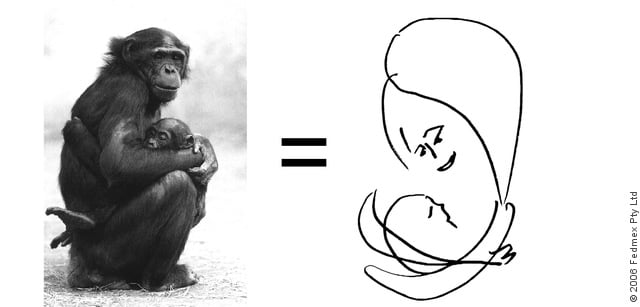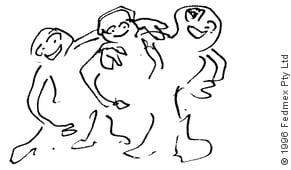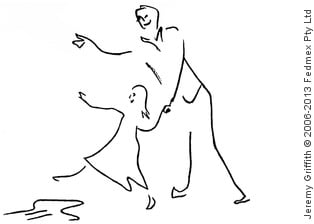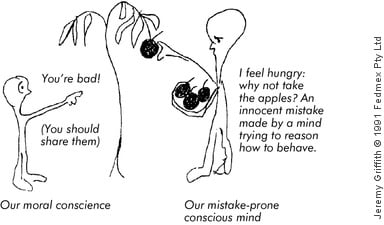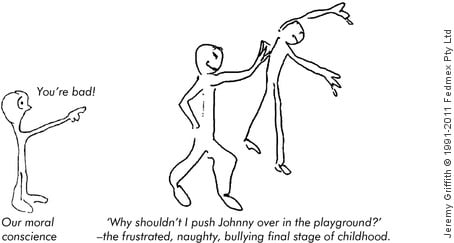Freedom Expanded: Book 1—The Human Condition Explained
Part 3:11A Infancy and Childhood
Infancy
As explained in Part 3:4, it was through the process of love-indoctrination, the nurturing of infants, that our ape ancestor was able to develop unconditionally selfless, fully altruistic, cooperative, moral, integrative behaviour—a process the bonobos are currently perfecting, as illustrated by the following photo of the bonobo Matata hugging her adopted son, Kanzi. Nurturing is what made us human, a truth that the image of the Madonna and child has been the archetypal representation of. And, as has just been briefly explained, with the development of selflessness consciousness was able to emerge, and with consciousness came all the stages of maturation that consciousness itself had to progress through—namely Infancy, Childhood, Adolescence, and Adulthood.
The first stage of Infancy is when humans become sufficiently conscious, sufficiently aware of cause and effect to realise that ‘I exist’, that we are at the centre of constantly changing experiences. As mentioned in Part 3:4, the nurturing bonobos, who are in the final stages of this ‘infancy, emerging-consciousness, self-aware’ stage, are the most intelligent of all non-human primates, and some of that intelligence is apparent in Matata’s expression.
The species: our ape ancestor—20 to 5 million years ago
The individual: 0 to 3 years old
Childhood
Childhood is when consciousness begins to experiment in self-adjustment and manage events to its own chosen ends. It comprises three stages: Early Happy, Innocent Childhood; Middle Demonstrative Childhood; and Late Naughty Childhood.
The species: the australopithecines—5 to 1 million years ago
The individual: 4 to 11 years old
Early Happy, Innocent Childhood
This is the time when the intellect becomes sufficiently able to understand the relationship between cause and effect to begin actively experimenting—‘playing’—with the conscious power to self-manage and self-adjust.
The species: the early australopithecines including Australopithecus afarensis—5 to 3 million years ago
The individual: 4, 5 and 6 years old
While infancy is all about receiving unconditionally selfless treatment or ‘love’, early happy, innocent childhood is predominantly about beginning to outwardly express the emerging intellectual ability to experiment in self-management. It’s when the power of free will is innocently tested or played with; it’s when we start to experiment with the awesome ability that consciousness provides of managing events to bring about the conscious mind’s own desired outcome. Indeed, we call it ‘play’ in recognition of the naive unawareness children have at this stage of the problems associated with having free will, particularly their unawareness of the conflict it inevitably leads to with our instincts. We are still, as it were, holding onto our mother’s apron strings, our instinctive orientations, with one hand, while carrying out short experiments in conscious self-management with the other. We are still depending on our established instinctive responses, namely our nurtured orientation to love, for the overall management of our life, but we are also beginning to actively experiment in managing our life from a basis of understanding. The first demonstrative displays of the emerging ability to consciously manage cause and effect appear during this stage. In the case of humans today, it is the ‘Look at me, Daddy, I can jump puddles’ stage where reinforcing admiration from parents of the emerging conscious ability to manage events is so important.
Middle Demonstrative Childhood
In the Middle Demonstrative Childman stage, the intellect becomes demonstrative of the power of free will and experiences its first encounter with the frustrations of a conflict with the instincts, which is the human condition.
The species: Australopithecus africanus—3 to 2 million years ago
The individual: 7 and 8 years old
By mid-childhood consciousness is sufficiently able to make enough sense of experience to successfully manage and thus plan activities for not just minutes ahead, but for hours and even days—a development that empowers the individual to be both outwardly marvelling at, and demonstrative of, its intellectual power. It is at this stage of active self-management that the results of some experiments in self-adjustment also begin to attract criticism from the instinctive self. ‘There are some apples; why shouldn’t I take them all for myself?’—an innocuous mistake by a mind trying to reason how to behave, but the instinctive self, orientated to behaving unconditionally selflessly, makes the intellect aware that this is not the right way to behave. The emerging intellect has, in effect, been disobedient, but the conscious self doesn’t know why it has ‘disobeyed’ the instincts; it isn’t able to understand and explain that it has become a conscious being. Also, the conscious self can’t stop ‘disobeying’ the instincts; now that it is capable of thought it can’t stop thinking. While the conscious self can’t explain its actions it does know that what it is doing is not something it should stop doing, it is not something bad, it is not something deserving of this feeling of opposition coming from within itself. In fact, the intellect is quite proud of its achievements in self-management. Out of frustration, the precursors of the defensive, retaliatory reactions of anger, egocentricity and alienation start to appear. Some aggressive ‘nastiness’ creeps into the conscious self’s behaviour. Furthermore, in this situation of feeling unfairly criticised, any positive feedback reinforcement begins to be deliberately sought after, which is the beginning of egocentricity—the conscious thinking self or ego’s preoccupation with trying to defend its worth, assert that it is good and not bad. At this point, the intellect also begins experimenting in evading the unwarranted criticism. These early experiments in denial take the form of blatant lying. Lying is an art and initially we have little skill in it, simply blurting out, ‘But Mum, Billy told me to do it.’ From demonstrating the power of free will, the child has started to feel the first real aggravations from the horror of the injustice of the human condition. Of course, for children growing up during humanity’s australopithecine childhood, love would still have very much been the dominant influence in life overall and these defensive expressions of frustration would have been restricted to feelings and actions rather than expressed in words. In fact, language wasn’t developed by our forebears until the early adolescent stage when alienation appeared and the need to somehow explain our extremely unnatural behaviour and needs arose. Anthropologist Richard Leakey’s study of brain cases in fossil skulls for the imprint of Broca’s area, the word-organising centre of the brain, evidences this development: ‘Homo had a greater need than the australopithecines for a rudimentary language’ (Origins, 1977, p.205 of 264). Prior to the emergence of alienation we were all instinctively aware of and in sync with each other. Apart from contact calls there was little need to talk.
Late Naughty Childhood
The Late Naughty Childman stage represents the time when the intellect naively lashes out at the increasing unjust criticism it is encountering as a result of its first tentative experiments in self-adjustment.
The species: The robust australopithecines (A. robustus and A. boisei)—2.5 to 1 million years ago
The individual: 9, 10 and 11 years old
The late naughty stage of Childhood
Since school teachers become very aware of the changing behaviour of children under their care, I asked a teacher to describe what she and her colleagues knew of the stages children and early adolescents go through. These are the main points from the response she collected: ‘Six and seven-year-olds are considered to be very compliant, but by eight children are starting to test the waters and challenge the world a little.’ She continued, ‘the eight-year-olds can be annoying and a little naughty’, while ‘nine and ten-year-olds can be hard to handle as they seem to hit a phase of recklessness’ and ‘are considered naughty’. She noted that ‘Teachers love teaching 11 and 12-year-olds because it is during this stage that children become civilised’ but that ‘Teachers consider years nine and ten, when students are 14, 15 and 16 years old, the most difficult to teach. The adolescents seem to be at complete odds with what is expected of them. Most teachers are terrified of these extremely uncooperative mid-teenage ages’ (personal communication, 1997). These insights evidence the explanations being given of the stages of maturation of consciousness through childhood—and confirm the agonising stage of Resignation that occurs in early adolescence.
Of course, as the human condition developed children were going to be increasingly influenced by the upset world in which they were raised, and it would become harder to differentiate what upset in them was a result of those circumstances or from their own experiments in understanding. However, by eight years of age we can expect that even in the original situation, where there was little or no upset in the world, the child would justifiably be feeling resentful towards the ‘criticism’ emanating from their instinctive self of their tentative efforts to self-manage their life using understanding. And, unable to adequately cope with this ‘criticism’ with understanding of it, we can expect that the child would begin to retaliate against the criticism as the only form of defence available to them. The problem then, however, would be that these early, relatively mild experiments in retaliation—of anger, selfishness and dishonest excuse-making in mid-childhood—would have the alarming effect of greatly compounding the ‘criticism’ from the child’s perfectly integratively orientated, moral instinctive self. From being mildly insecure we can expect the child to now feel guilty and that this drastic escalation in criticism and thus frustration would be a contributing factor to the turbulent, boisterous ‘naughty nines’ that parents and teachers have labelled this stage. By the end of childhood, at the ages of 10 and 11, we can expect the resentment and frustration to be such that it would express itself in the form of taunting and bullying. The child would be belligerently lashing out at the unjust world: ‘Why shouldn’t I feel resentful and retaliate?’, ‘Why shouldn’t I shove you around if I can, especially since I’m bigger and stronger?’, and ‘What’s wrong with being selfish and aggressive anyway?’
In the situation that exists today, where the external upset is almost overwhelming, we can expect that almost all of the child’s upset will have resulted from their encounter with external upset. The increasingly thoughtful child can see the whole horribly upset world and would be understandably totally bewildered and deeply troubled by it. Eight-year-olds will only be beginning to be consciously aware of the horror of the state of the world they have been born into, but by nine they will have become aware of that horror and be needing a lot of reassurance that ‘Everything is going to be alright.’ In fact, nine-year-olds can be so troubled by the imperfection of the world that they go through a process of trying not to accept that it is true. By 10, this despair about the state of the world reaches desperation levels with nightmares of distress for children. It is a very unhappy, lonely, needing-of-love time for them. So at 11 they enter the ‘Peter Pan’ stage where they decide they don’t want to grow up; they decide they want to stay a child forever, surrounded by all the things they love, and not ever become part of the horror world they have discovered. It is no wonder ‘Teachers love teaching 11 and 12-year-olds’ who have ‘become civilised’—they’re essentially tame compared to the ‘reckless’, ‘naughty’ ‘nine and ten-year-olds’.
There is evidence in the fossil record of the description that has been given of these stages of Childman. The early Australopithecus afarensis, who have been described as occupying the early happy, prime of innocence stage, and the subsequent Australopithecus africanus, who have been described as being in the middle demonstrative childhood stage, are both finely built compared to the much more robustly built Australopithecus boisei and associated Australopithecus robustus, both of whom have been described here as being in the Late Naughty Childman stage. Anthropologists have even placed the more robust late australopithecines on a separate, dead-end branch to Homo, but that has to be impossible because for branching to occur there has to be deflecting influences, such as when Darwin’s finches gradually became adapted to different food niches on the Galápagos Islands, and in our case there was only one major development going on and that was the psychological one. In a situation where there is only one all-dominant influence causing change there is no opportunity for divergence to develop. From our species’ infancy, humans have been under the all-dominant influence of what was occurring in our heads, namely the development of consciousness and its psychological consequences. Any other influence was so secondary as to be ineffectual in causing our path to branch. But if the robust australopithecines weren’t a separate branch, why was there such a big difference between them and the much more gracile or fine featured preceding A. afarensis and A. africanus, and the variety of early humans they gave rise to, the also much more gracile Homo habilis? The answer has to lie in the psychological differences between the much quieter, love-immersed A. afarensis and A. africanus, the extroverted, boisterous bullying A. boisei and A. robustus, and the introverted, sobered, quiet early adolescent H. habilis, who will be described shortly.
Late Naughty Childman, A. robustus and A. boisei, had comparatively big frames and skulls that were especially heavily built with very pronounced cranial and facial bone structures. Anthropologists recognise that these skull modifications came about to support the much stronger facial muscles that were required to work the heavy jaw and huge grinding teeth that characterise these late australopithecines. We know from such evidence as the wear patterns on their teeth that the australopithecines were vegetarian, but why did the later australopithecines need bigger grinding teeth? What dietary change occurred, and why? Being extroverted, increasingly naughty and roughly behaved, the late australopithecines were like older children today who would rather be out playing than eating, but such an extremely physically assertive and energetic lifestyle required fuel. Not being sufficiently conscious to attempt self-management, all other animal species exert only enough energy to secure their necessary food, space, shelter and a mate—they are conservative energy users—but, with their rough, energetic play, late childhood humans became the first non-conservative energy users on Earth. In order to ‘eat and run’ Late Naughty Childman would have needed a readily available food source that they could eat quickly and, being vegetarian, they would have needed a lot of it because vegetables do not convert into as much energy as meat for instance, which was not to appear on humanity’s dining table until upset developed. (While the australopithecines, in their naughtiness, would have been capable of being rough and possibly even cruel at times to animals, they were not yet upset with innocence and thus killing innocent animals regularly, which, as will be explained shortly, is what so called ‘hunting’ was really all about for upset humans and what finally led to meat-eating.) As such, we can imagine certain edible varieties of nuts, hard-shelled fruits, fibrous roots and tubers would have provided a ready fuel supply, which explains the need for massive grinding teeth and the necessary facial structure. In contrast, however, to these late australopithecines, H. habilis was an entirely different individual. Introspective, deeply thoughtful and sobered, H. habilis was no longer interested in physically intimidating the world, and therefore did not need great quantities of energy and thus food.
Another feature of the fossil record of early humans is the evidence it provides of the overlap between the different varieties. For example, in what is the biggest overlap by far, australopithecines were possibly still in existence up to 1.5 million years after H. habilis appeared. Again, this evidence has been used to argue that the late australopithecines branched away from the Homo line, but now that we can take into account what was happening psychologically, the overlap becomes understandable. Just as there are very early models of cars still around today, long after they have been superseded, so groups of early, less intelligent varieties of humans carried on long after they had been superseded. Of course, the best example of such overlapping in the anthropological record is the existence today of remnants of our infant ape ancestors, specifically the non-human primates of today, such as chimpanzees and gorillas. Apes are not a branched development from the human line at all—they are on exactly the same development path, but at a much, much earlier stage.


